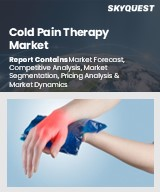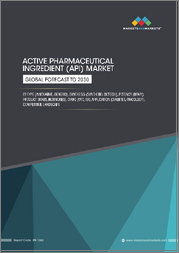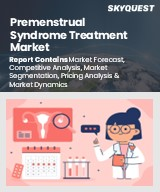
|
시장보고서
상품코드
1675319
소화관용 OTC 의약품 시장 : 약제 클래스별, 적응증별, 최종사용자별, 지역별(2025-2033년)Gastrointestinal OTC Drugs Market by Drug Class, Indication (Gastroesophageal Reflux Disease or Heartburn, Constipation, Diarrhea, Motion Sickness, and Others), End User, and Region 2025-2033 |
||||||
세계의 소화관용 OTC 의약품 시장 규모는 2024년에 437억 달러에 달했습니다. 향후 IMARC Group은 시장이 2033년까지 622억 달러에 달하며, 2025-2033년에 3.82%의 성장률(CAGR)을 보일 것으로 예측하고 있습니다. 위장질환의 유병률 상승, 소화기계 건강에 대한 대중 의식의 향상, 최근 첨단 제제의 개발이 시장을 촉진하는 주요 요인입니다.
소화관용 OTC 의약품은 위장 증상을 완화하고 전반적인 소화기 건강을 증진시키는 비처방 의약품을 말합니다. 완하제, 제산제, H2 차단제, 양성자 펌프 억제제(PPI), 구토제, 장내 항염증약, 설사약 등이 포함됩니다. 소화관용 OTC 의약품은 소화불량, 변비, 속쓰림, 설사, 멀미, 위산 역류, 메스꺼움, 과민성 대장 증후군(IBS), 복통 등의 치료에 널리 사용되고 있습니다. 비용 효율적이고, 편리하고 쉽게 구할 수 있는 제품으로, 즉각적인 완화 효과를 제공하고, 환자의 편안함을 증진시키며, 자가 관리를 가능하게 합니다. 소화관용 OTC 의약품은 또한 장내 환경을 개선하고, 유익한 박테리아를 복원하고, 향후 합병증을 예방하고, 통증, 복부 팽만감, 복부 불편감, 구토와 같은 다양한 증상의 심각성을 최소화하는 데 도움이 될 수 있습니다.
소화기용 OTC 의약품 시장 동향 :
좌식 생활과 건강에 해로운 식습관으로 인한 위장 장애의 유병률 증가는 시장 성장을 가속하는 중요한 요인 중 하나입니다. 소화관용 OTC 의약품은 감염, 소화불량, 급성 설사, 가슴앓이, 위식도역류질환(GERD), 변비, 복부팽만감, 입덧 등을 치료하는 데 널리 사용되고 있습니다. 또한 소화 개선, 장 건강 증진, 영양소의 적절한 분해 및 흡수를 보장하기 위한 제품 용도 증가는 소화 건강에 대한 대중의 인식이 높아짐에 따라 시장 성장의 원동력이 되고 있습니다. 이와 함께 건강 상태를 관리하고 미래의 건강 합병증을 예방하기 위한 셀프 케어와 소비자 권한 부여라는 새로운 동향이 또 다른 성장 동력으로 작용하고 있습니다. 또한 최근 발포성 정제, 액상, 현탁액, 필름 스트립, 츄어블 제품 등의 첨단 제형 개발은 약물의 효능을 높이고, 흡수율을 높이며, 투여 횟수를 줄여 시장 성장에 긍정적인 영향을 미치고 있습니다. 이와 더불어, 블리스터 팩, 리실러블 파우치, 1회 분량 포장과 같은 편리하고 여행하기 쉬운 포장의 도입은 시장 성장을 가속하고 있습니다. 이와는 별도로, 비침습적 치료에 대한 소비자의 선호도가 높아지면서 일반적인 소화기 질환을 관리하고 즉각적인 완화를 제공하는 제품에 대한 수요가 증가하고 있습니다. 또한 여러 제조업체의 TV 광고, 소셜미디어, 인플루언서 마케팅, 유명인 추천을 통한 적극적인 홍보 및 브랜딩 캠페인이 시장 성장을 가속하고 있습니다. 기타 노령 인구 증가, 소비자의 지출 능력 증가, E-Commerce 플랫폼에서 제품을 쉽게 구할 수 있는 점 등이 시장 성장을 가속할 것으로 예상됩니다.
이 보고서에서 다룬 주요 질문
- 세계 소화관용 OTC 의약품 시장의 규모는?
- 2025-2033년 세계 소화기용 OTC 의약품 시장의 예상 성장률은?
- 세계 소화기용 OTC 의약품 시장을 촉진하는 주요 요인은 무엇인가?
- COVID-19가 전 세계 소화기용 OTC 의약품 시장에 미치는 영향은?
- 세계 소화기용 OTC 의약품 시장의 주요 지역은?
- 세계 소화기용 OTC 의약품 시장의 주요 기업은?
목차
제1장 서문
제2장 조사 범위와 조사 방법
- 조사의 목적
- 이해관계자
- 데이터 소스
- 1차 정보
- 2차 정보
- 시장 추정
- 보텀업 어프로치
- 톱다운 어프로치
- 조사 방법
제3장 개요
제4장 서론
- 개요
- 주요 업계 동향
제5장 세계의 소화관용 OTC 의약품 시장
- 시장 개요
- 시장 실적
- COVID-19의 영향
- 시장 예측
제6장 시장 내역 : 약제 클래스별
- 설사약
- 소화관암 치료
- 위산 억제제
- 지사제
- 프로톤펌프 저해제
- H2 저해제
- 위산 중화제
- 장 항염증
- 항구토제
제7장 시장 내역 : 적응증별
- 위식도 역류증(GERD) 또는 속쓰림
- 변비
- 설사
- 멀미
- 기타
제8장 시장 내역 : 최종사용자별
- 병원
- 클리닉
- 기타
제9장 시장 내역 : 지역별
- 북미
- 미국
- 캐나다
- 아시아태평양
- 중국
- 일본
- 인도
- 한국
- 호주
- 인도네시아
- 기타
- 유럽
- 독일
- 프랑스
- 영국
- 이탈리아
- 스페인
- 러시아
- 기타
- 라틴아메리카
- 브라질
- 멕시코
- 기타
- 중동 및 아프리카
- 시장 내역 : 국가별
제10장 촉진요인·억제요인·기회
- 개요
- 촉진요인
- 억제요인
- 기회
제11장 밸류체인 분석
제12장 Porter's Five Forces 분석
- 개요
- 바이어의 교섭력
- 공급 기업의 교섭력
- 경쟁의 정도
- 신규 진출업체의 위협
- 대체품의 위협
제13장 가격 분석
제14장 경쟁 구도
- 시장 구조
- 주요 기업
- 주요 기업의 개요
- Boehringer Ingelheim GmbH
- Johnson & Johnson
- Prestige Consumer Healthcare Inc.
- Purdue Pharma L.P
- Sanofi
- Zydus Lifesciences Limited
The global gastrointestinal OTC drugs market size reached USD 43.7 Billion in 2024. Looking forward, IMARC Group expects the market to reach USD 62.2 Billion by 2033, exhibiting a growth rate (CAGR) of 3.82% during 2025-2033. The rising prevalence of gastrointestinal disorders, increasing awareness among the masses regarding digestive health, and the recent development of advanced formulations represent some of the key factors driving the market.
Gastrointestinal over-the-counter (OTC) drugs refer to non-prescription medications that alleviate gastrointestinal symptoms and promote overall digestive wellness. It includes laxatives, antacids, H2 blockers, proton pump inhibitors (PPIs), anti-emetics, bowel anti-inflammatory, and anti-diarrheal medications. Gastrointestinal OTC drugs are widely used to treat indigestion, constipation, heartburn, diarrhea, motion sickness, acid reflux, nausea, irritable bowel syndrome (IBS), and abdominal pain. It is a cost-effective, convenient, and easily accessible product that provides immediate relief, enhances patient comfort, and allows self-management. Gastrointestinal OTC drugs also aid in improving gut health, restoring beneficial bacteria, preventing future complications, and minimizing the severity of various symptoms, such as pain, bloating, abdominal discomfort, and vomiting.
Gastrointestinal OTC Drugs Market Trends:
The rising prevalence of gastrointestinal disorders due to sedentary lifestyles and unhealthy eating habits is one of the key factors providing a thrust to the market growth. Gastrointestinal OTC drugs are widely used to treat infections, dyspepsia, acute diarrhea, heartburn, gastroesophageal reflux disease (GERD), constipation, bloating, and morning sickness. Furthermore, the increasing product applications to improve digestion, promote gut health, and ensure proper breakdown and absorption of nutrients, owing to the growing awareness among the masses regarding digestive health, is providing an impetus to the market growth. In line with this, the emerging trends of self-care and consumer empowerment to manage well-being and prevent future health complications are acting as another growth-inducing factor. Additionally, the recent development of advanced formulations, such as effervescent tablets, liquids, suspensions, film strips, and chewable products, which enhances the effectiveness of the drugs, increases absorption, and reduces the frequency of dosing, is positively influencing the market growth. Besides this, the introduction of convenient and travel-friendly packaging, such as blister packs, resealable pouches, and single-dose packets, is propelling the market growth. Apart from this, the rising consumer preference for non-invasive treatments is facilitating product demand to manage common digestive issues and provide immediate relief. Moreover, aggressive promotional and branding campaigns by several manufacturers through television (TV) commercials, social media, influencer marketing, and celebrity endorsement is strengthening the market growth. Other factors, including the rising geriatric populations, increasing expenditure capacities of consumers, and easy availability of products across e-commerce platforms, are anticipated to drive the market growth.
Key Market Segmentation:
Drug Class Insights:
- Laxatives
- Gastrointestinal Cancer Treatments
- Gastric Acid Reducers
- Anti-Diarrheal
- Proton Pump Inhibitors
- H2 Inhibitors
- Gastric Acid Neutralizers
- Bowel Anti-Inflammatory
- Anti-Emetics
Indication Insights:
- Gastroesophageal Reflux Disease (GERD) or Heartburn
- Constipation
- Diarrhea
- Motion Sickness
- Others
End User Insights:
- Hospitals
- Clinics
- Others
Regional Insights:
- North America
- United States
- Canada
- Asia Pacific
- China
- Japan
- India
- South Korea
- Australia
- Indonesia
- Others
- Europe
- Germany
- France
- United Kingdom
- Italy
- Spain
- Russia
- Others
- Latin America
- Brazil
- Mexico
- Others
- Middle East and Africa
- The report has also provided a comprehensive analysis of all the major regional markets, which include North America (the United States and Canada); Asia Pacific (China, Japan, India, South Korea, Australia, Indonesia, and others); Europe (Germany, France, the United Kingdom, Italy, Spain, Russia, and others); Latin America (Brazil, Mexico, and others); and the Middle East and Africa. According to the report, North America was the largest market for gastrointestinal OTC drugs. Some of the factors driving the North America gastrointestinal OTC drugs market included the rising prevalence of gastrointestinal disorders, increasing awareness among the masses, and various product innovations.
Competitive Landscape:
- The report has also provided a comprehensive analysis of the competitive landscape in the global gastrointestinal OTC drugs market. Competitive analysis such as market structure, market share by key players, player positioning, top winning strategies, competitive dashboard, and company evaluation quadrant has been covered in the report. Also, detailed profiles of all major companies have been provided. Some of the companies covered include Boehringer Ingelheim GmbH, Johnson & Johnson, Prestige Consumer Healthcare Inc., Purdue Pharma L.P, Sanofi, Zydus Lifesciences Limited, etc. Kindly note that this only represents a partial list of companies, and the complete list has been provided in the report.
Key Questions Answered in This Report
- 1.How big is the global gastrointestinal OTC drugs market?
- 2.What is the expected growth rate of the global gastrointestinal OTC drugs market during 2025-2033?
- 3.What are the key factors driving the global gastrointestinal OTC drugs market?
- 4.What has been the impact of COVID-19 on the global gastrointestinal OTC drugs market?
- 5.What are the key regions in the global gastrointestinal OTC drugs market?
- 6.Who are the key players/companies in the global gastrointestinal OTC drugs market?
Table of Contents
1 Preface
2 Scope and Methodology
- 2.1 Objectives of the Study
- 2.2 Stakeholders
- 2.3 Data Sources
- 2.3.1 Primary Sources
- 2.3.2 Secondary Sources
- 2.4 Market Estimation
- 2.4.1 Bottom-Up Approach
- 2.4.2 Top-Down Approach
- 2.5 Forecasting Methodology
3 Executive Summary
4 Introduction
- 4.1 Overview
- 4.2 Key Industry Trends
5 Global Gastrointestinal OTC Drugs Market
- 5.1 Market Overview
- 5.2 Market Performance
- 5.3 Impact of COVID-19
- 5.4 Market Forecast
6 Market Breakup by Drug Class
- 6.1 Laxatives
- 6.1.1 Market Trends
- 6.1.2 Market Forecast
- 6.2 Gastrointestinal Cancer Treatments
- 6.2.1 Market Trends
- 6.2.2 Market Forecast
- 6.3 Gastric Acid Reducers
- 6.3.1 Market Trends
- 6.3.2 Market Forecast
- 6.4 Anti-Diarrheal
- 6.4.1 Market Trends
- 6.4.2 Market Forecast
- 6.5 Proton Pump Inhibitors
- 6.5.1 Market Trends
- 6.5.2 Market Forecast
- 6.6 H2 Inhibitors
- 6.6.1 Market Trends
- 6.6.2 Market Forecast
- 6.7 Gastric Acid Neutralizers
- 6.7.1 Market Trends
- 6.7.2 Market Forecast
- 6.8 Bowel Anti-Inflammatory
- 6.8.1 Market Trends
- 6.8.2 Market Forecast
- 6.9 Anti-Emetics
- 6.9.1 Market Trends
- 6.9.2 Market Forecast
7 Market Breakup by Indication
- 7.1 Gastroesophageal Reflux Disease (GERD) or Heartburn
- 7.1.1 Market Trends
- 7.1.2 Market Forecast
- 7.2 Constipation
- 7.2.1 Market Trends
- 7.2.2 Market Forecast
- 7.3 Diarrhea
- 7.3.1 Market Trends
- 7.3.2 Market Forecast
- 7.4 Motion Sickness
- 7.4.1 Market Trends
- 7.4.2 Market Forecast
- 7.5 Others
- 7.5.1 Market Trends
- 7.5.2 Market Forecast
8 Market Breakup by End User
- 8.1 Hospitals
- 8.1.1 Market Trends
- 8.1.2 Market Forecast
- 8.2 Clinics
- 8.2.1 Market Trends
- 8.2.2 Market Forecast
- 8.3 Others
- 8.3.1 Market Trends
- 8.3.2 Market Forecast
9 Market Breakup by Region
- 9.1 North America
- 9.1.1 United States
- 9.1.1.1 Market Trends
- 9.1.1.2 Market Forecast
- 9.1.2 Canada
- 9.1.2.1 Market Trends
- 9.1.2.2 Market Forecast
- 9.1.1 United States
- 9.2 Asia-Pacific
- 9.2.1 China
- 9.2.1.1 Market Trends
- 9.2.1.2 Market Forecast
- 9.2.2 Japan
- 9.2.2.1 Market Trends
- 9.2.2.2 Market Forecast
- 9.2.3 India
- 9.2.3.1 Market Trends
- 9.2.3.2 Market Forecast
- 9.2.4 South Korea
- 9.2.4.1 Market Trends
- 9.2.4.2 Market Forecast
- 9.2.5 Australia
- 9.2.5.1 Market Trends
- 9.2.5.2 Market Forecast
- 9.2.6 Indonesia
- 9.2.6.1 Market Trends
- 9.2.6.2 Market Forecast
- 9.2.7 Others
- 9.2.7.1 Market Trends
- 9.2.7.2 Market Forecast
- 9.2.1 China
- 9.3 Europe
- 9.3.1 Germany
- 9.3.1.1 Market Trends
- 9.3.1.2 Market Forecast
- 9.3.2 France
- 9.3.2.1 Market Trends
- 9.3.2.2 Market Forecast
- 9.3.3 United Kingdom
- 9.3.3.1 Market Trends
- 9.3.3.2 Market Forecast
- 9.3.4 Italy
- 9.3.4.1 Market Trends
- 9.3.4.2 Market Forecast
- 9.3.5 Spain
- 9.3.5.1 Market Trends
- 9.3.5.2 Market Forecast
- 9.3.6 Russia
- 9.3.6.1 Market Trends
- 9.3.6.2 Market Forecast
- 9.3.7 Others
- 9.3.7.1 Market Trends
- 9.3.7.2 Market Forecast
- 9.3.1 Germany
- 9.4 Latin America
- 9.4.1 Brazil
- 9.4.1.1 Market Trends
- 9.4.1.2 Market Forecast
- 9.4.2 Mexico
- 9.4.2.1 Market Trends
- 9.4.2.2 Market Forecast
- 9.4.3 Others
- 9.4.3.1 Market Trends
- 9.4.3.2 Market Forecast
- 9.4.1 Brazil
- 9.5 Middle East and Africa
- 9.5.1 Market Trends
- 9.5.2 Market Breakup by Country
- 9.5.3 Market Forecast
10 Drivers, Restraints, and Opportunities
- 10.1 Overview
- 10.2 Drivers
- 10.3 Restraints
- 10.4 Opportunities
11 Value Chain Analysis
12 Porters Five Forces Analysis
- 12.1 Overview
- 12.2 Bargaining Power of Buyers
- 12.3 Bargaining Power of Suppliers
- 12.4 Degree of Competition
- 12.5 Threat of New Entrants
- 12.6 Threat of Substitutes
13 Price Analysis
14 Competitive Landscape
- 14.1 Market Structure
- 14.2 Key Players
- 14.3 Profiles of Key Players
- 14.3.1 Boehringer Ingelheim GmbH
- 14.3.1.1 Company Overview
- 14.3.1.2 Product Portfolio
- 14.3.1.3 SWOT Analysis
- 14.3.2 Johnson & Johnson
- 14.3.2.1 Company Overview
- 14.3.2.2 Product Portfolio
- 14.3.2.3 Financials
- 14.3.2.4 SWOT Analysis
- 14.3.3 Prestige Consumer Healthcare Inc.
- 14.3.3.1 Company Overview
- 14.3.3.2 Product Portfolio
- 14.3.3.3 Financials
- 14.3.3.4 SWOT Analysis
- 14.3.4 Purdue Pharma L.P
- 14.3.4.1 Company Overview
- 14.3.4.2 Product Portfolio
- 14.3.5 Sanofi
- 14.3.5.1 Company Overview
- 14.3.5.2 Product Portfolio
- 14.3.5.3 Financials
- 14.3.5.4 SWOT Analysis
- 14.3.6 Zydus Lifesciences Limited
- 14.3.6.1 Company Overview
- 14.3.6.2 Product Portfolio
- 14.3.6.3 Financials
- 14.3.6.4 SWOT Analysis
- 14.3.1 Boehringer Ingelheim GmbH
Kindly, note that this only represents a partial list of companies, and the complete list has been provided in the report.



















